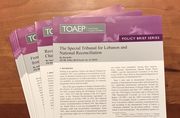Table of contents:
Element:
In Popović et al., the Trial Chamber upheld that:
"[a]n attack may be considered to have been directed against a civilian population if the civilian population was the 'primary rather than an incidental target of the attack'"."[1]
The Trial Chamber in Martić further found that:
"a direct attack on civilians may be inferred from the indiscriminate character of the weapon used."[2]
4.1.1. Evidence of the civilian character of the population or individuals being targeted.
In the Katanga Trial Judgement, the Trial Chamber held that:
"Consonant with its approach to murder as a war crime, the Chamber understands "civilian" to mean any person who is not a member of either State or non-State armed forces. The term "civilian population" denotes "civilians as a group". In this connection, the Chamber will take account of factors such as the number and the conduct of the combatants present.
The Chamber considers that the crime may be established even if the military operation also targeted a legitimate military objective. It is important, however, to establish that the primary object of the attack was the civilian population or individual civilians. Thus, situations in which the attack is directed against a military objective and civilians are incidentally affected fall outwith article 8(2)(e)(i). It must be noted that indiscriminate attacks - proscribed by a rule of custom - may qualify as intentional attacks against the civilian population or individual civilians, especially where the damage caused to civilians is so great that it appears to the Chamber that the perpetrator meant to target civilian objectives. Use of weaponry that has indiscriminate effects may, inter alia, show that the attack was directed at the civilian population or individual civilians. The Chamber notes in this regard that an indiscriminate attack does not, however, automatically constitute an attack against the civilian population under article 8(2)(e)(i), as the subjective element is decisive in respect of the second case."[16]
"[T]he means and method used in the course of the attack, the status of the victims, their number, [...] the nature of the crimes committed in its course, the resistance to the assailants at the time and the extent to which the attacking force may be said to have complied or attempted to comply with the precautionary requirements of the laws of war.'[5] In addition, the distance between the victims and the source of fire, the ongoing combat activity at the time and location of the incident, the presence of military activities or facilities in the vicinity of the incident, the victims' appearance, including their age, gender, clothing and activity may also be relevant."[3]
4.1.2. Evidence of the civilians not taking direct part in hostilities being targeted
In the Mbarushimana Decision on the Confirmation of Charges, the Pre-Trial Chamber held that:
"As highlighted in the Abu Garda Confirmation Decision, there is no customary or treaty law definition of what constitutes direct participation in hostilities, although useful guidance is provided by the International Committee of the Red Cross ("ICRC"). However, loss of protection is only clear when a civilian uses weapons or other means to commit violence against human or material enemy forces, unless in selfdefence. Further, practice indicates that supplying food and shelter and sympathising with one belligerent party is an insufficient reason to deny civilians protection against attack. The term "civilian" in accordance with article 50(1) of the AP I, applies to anyone who is not a combatant, and in case of doubt, the person shall be considered to be a civilian. Additionally, a civilian population comprises all civilians as opposed to members of armed forces and any other legitimate combatants. Further, pursuant to article 50(3) of the AP I, the presence within the civilian population of individuals who do not fit within the definition of civilians does not deprive the entire population of its civilian character. Yet, civilians may lose protection only for such a time as they take direct part in hostilities or combat-related activities and not permanently. Further, the protection does not cease if such persons only use armed force in the exercise of their right to self-defence."[19]
The Trial Chamber in Sesay et al. at the SCSL held that:
The question of whether civilians have participated directly in hostilities has to be decided on
the specific facts of each case and there must be a sufficient causal relationship between the act
of participation and its immediate consequences. The Chamber takes the view that the direct:
"participation should be understood to mean "acts which by their nature or purpose, are intended to cause actual harm to the enemy personnel and material."[4]
The Trial Chamber in Perišić held that:
"[t]aking 'direct' part in the hostilities entails engaging in acts of war that by their nature or purpose are likely to cause actual harm to the personnel or materiel of the enemy armed forces."[5]
Footnotes:
[1] ICTY, Prosecutor v. Popović et al. ("Sebrenica"), "Judgment", IT-05-88-T, 10 June 2010, para. 753.
[2] ICTY, Martić Trial Judgment 12 June 2007, para. 471.
[3] ICTY, Prosecutor v. Perišić, "Judgement", IT-04-81-T, 6 September 2011, para. 95.
[4] SCSL, Prosecutor v. Sesay et al. ("RUF-case"), "Judgment", SCSL-04-15-T, 2 March 2009, para. 104.
[5] ICTY, Prosecutor v. Perišić, "Judgement", IT-04-81-T, 6 September 2011, para. 93.







